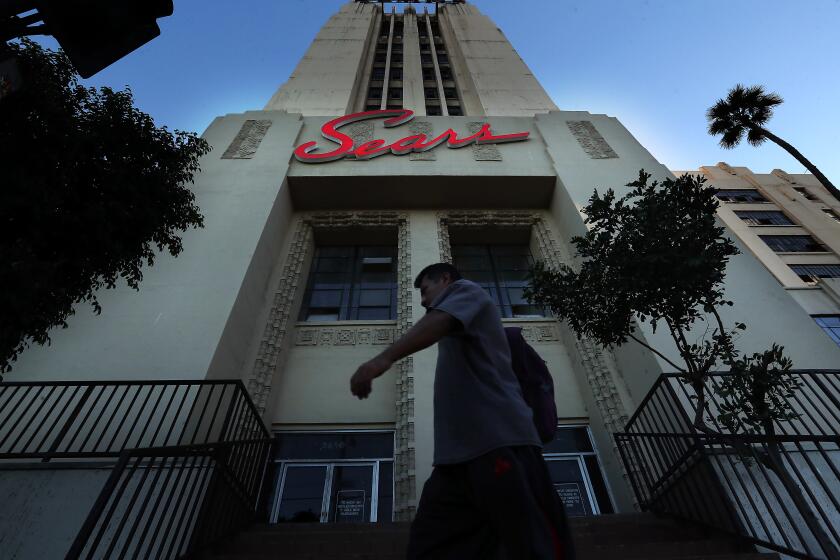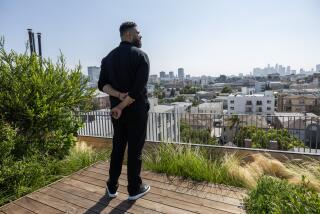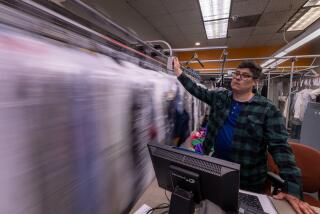Column: Can a giant, empty Sears building help solve homelessness in Los Angeles?
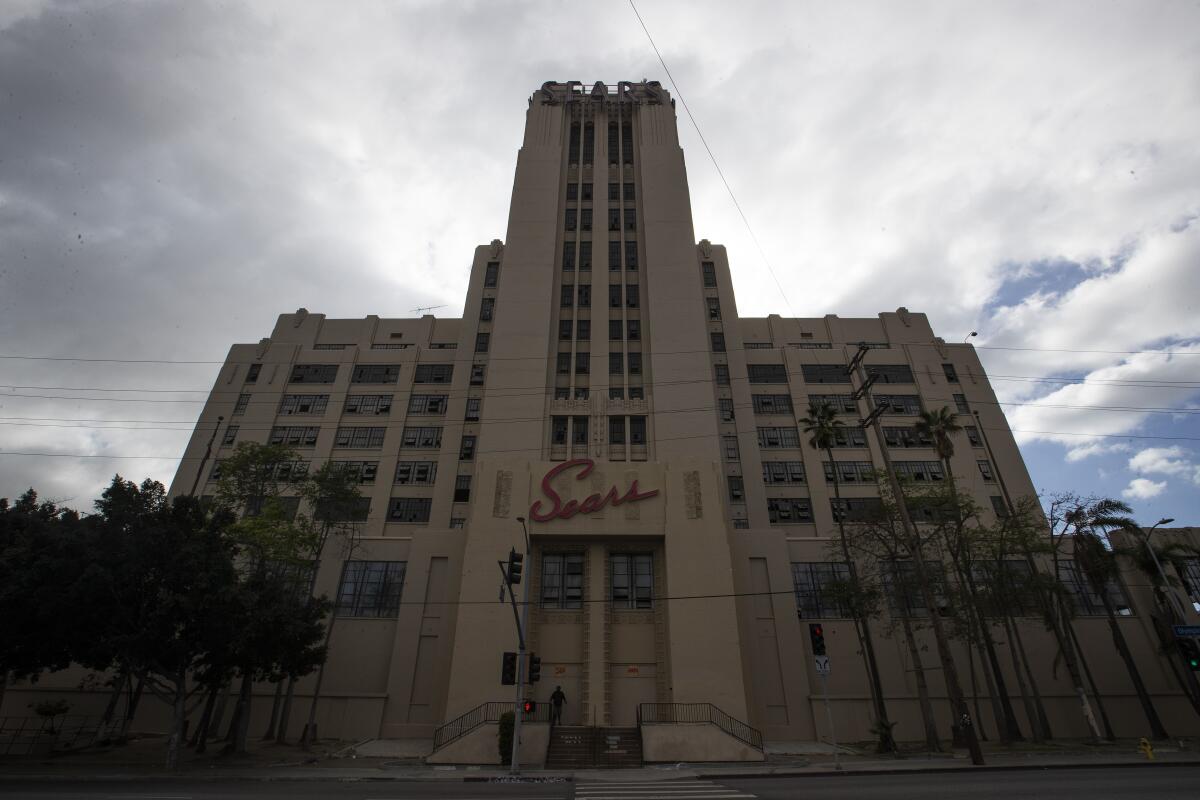
- Share via
Izek Shomof and Bill Taormina stood in the parking lot of the massive, historic, long-abandoned Sears distribution center on the outskirts of Boyle Heights. Together, they were about to pitch me on one of the most audacious civic projects I’ve ever heard of.
The 62-year-old Shomof bought the 1.6 million-square-foot property in 2013 and boasted to this paper then that he could “develop an entire neighborhood” there. For years, his company promised a mixed-use hipster hub branded as the Mail Order District complete with a food hall, live-work lofts and office space.

That plan — which promised to “revitalize” the industrial neighborhood around the Sears building — is still up on the website of the Shomof Group. But when I met Shomof to hear about his new proposal, he had a radically different vision:
Convert a concrete icon of L.A.’s Eastside into a full-fledged campus that helps the unhoused.
“I’ve been in L.A. for over 50 years, and I’ve seen homeless here that long,” said the multi-millionaire developer. “It’s time for it to be corrected once and for all. And after I met Bill, I think we’ve found a solution. Here, we can do a miracle.”
This is what Shomof and Taormina, a 71-year-old Anaheim businessman long involved in homeless issues across Orange County, want to do:
In nine acres of undeveloped land surrounding the Sears building, the two say they can house 2,000 people immediately in temporary shelters. On the first floor, Shomof and Taormina would build a one-stop shop for homeless — a pharmacy, a job training center, spaces for dentists and barbers, and even a kennel for pets — to get them off the streets and onto a better path.
The second floor would house a medical center and offices for groups across Southern California who deal with homelessness, to foster a collaborative spirit. Floors 3 through 10 — each the size of 3½ football fields — would hold more than 700 beds apiece in spacious dorm rooms for a total of nearly 5,900 beds in the building, with the capacity for more than 10,000.
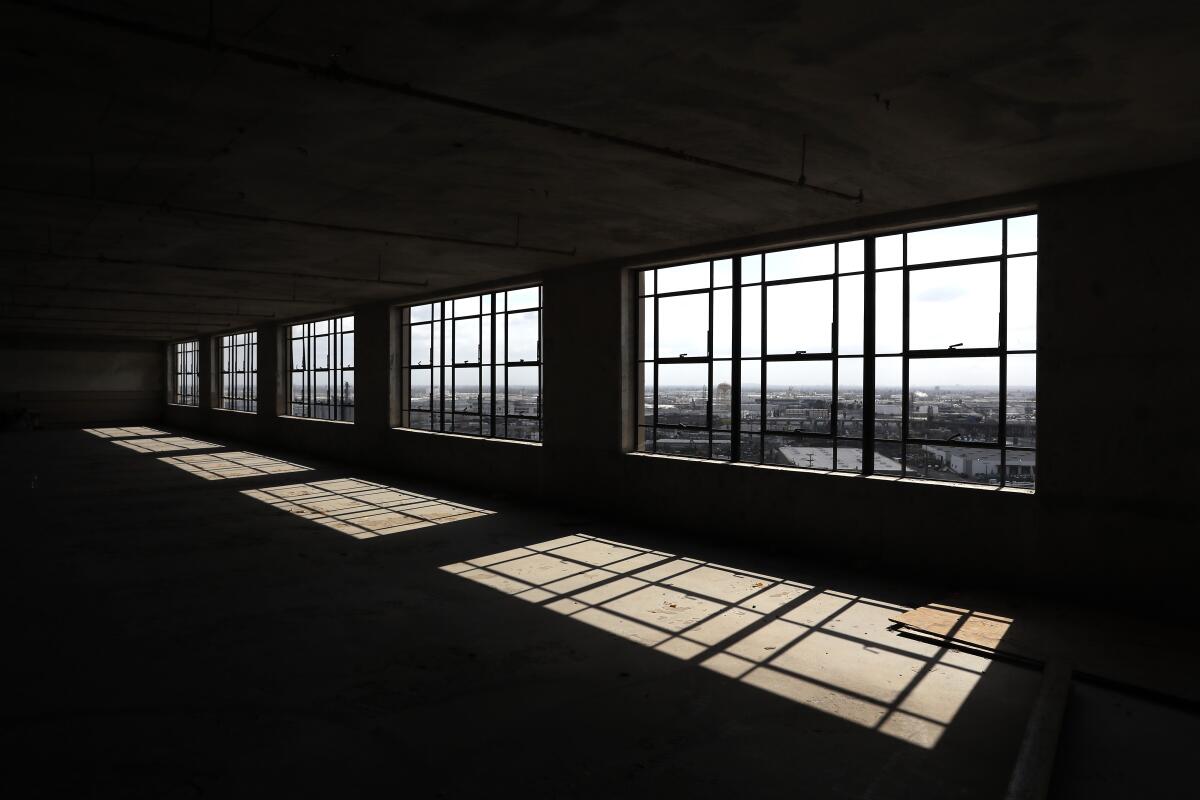
To put that number into perspective, the 2021 Housing Inventory County conducted by the Los Angeles Homeless Services Authority found that L.A.’s shelter capacity was 14,854 beds. One of the largest homeless facilities in Los Angeles, Union Rescue Mission, can hold about 1,000 people.
Shomof would spend an estimated $200 million for the initial build-out, while Taormina would assemble a coalition of homeless nonprofits to oversee day-to-day operations under the auspices of a joint-powers authority between L.A. and Los Angeles County. And once the so-called Life Rebuilding Center is complete, the parking lot would become the site of more than 1,000 permanent affordable housing units for people who graduate from the facility’s six-month rehabilitation program.
All this makes the California Aqueduct seem as big of an achievement as mowing the lawn.
And all of this, frankly, sounds delusional.
I told Shomof his proposal was too good to be true. He smiled.
“It’s true.”
We entered the dusty, empty Sears building, stripped down to cement pillars and roof. Construction workers in neon-green vests and bright-orange, long-sleeved shirts buzzed around. The remnants of an old boiler lay in the center of the floor.
“To build [a complex like] this today would be completely impossible,” Shomof said. “You can’t even get this much concrete anymore.”
We took an old-school cargo elevator to the second floor. “I want you to feel the light,” remarked the soft-spoken Taormina as he gestured to large windows with a great eastern view of Boyle Heights and beyond. “This will not be a warehouse and a bunk bed and a bag of Cheetos. Come broken, leave restored.”
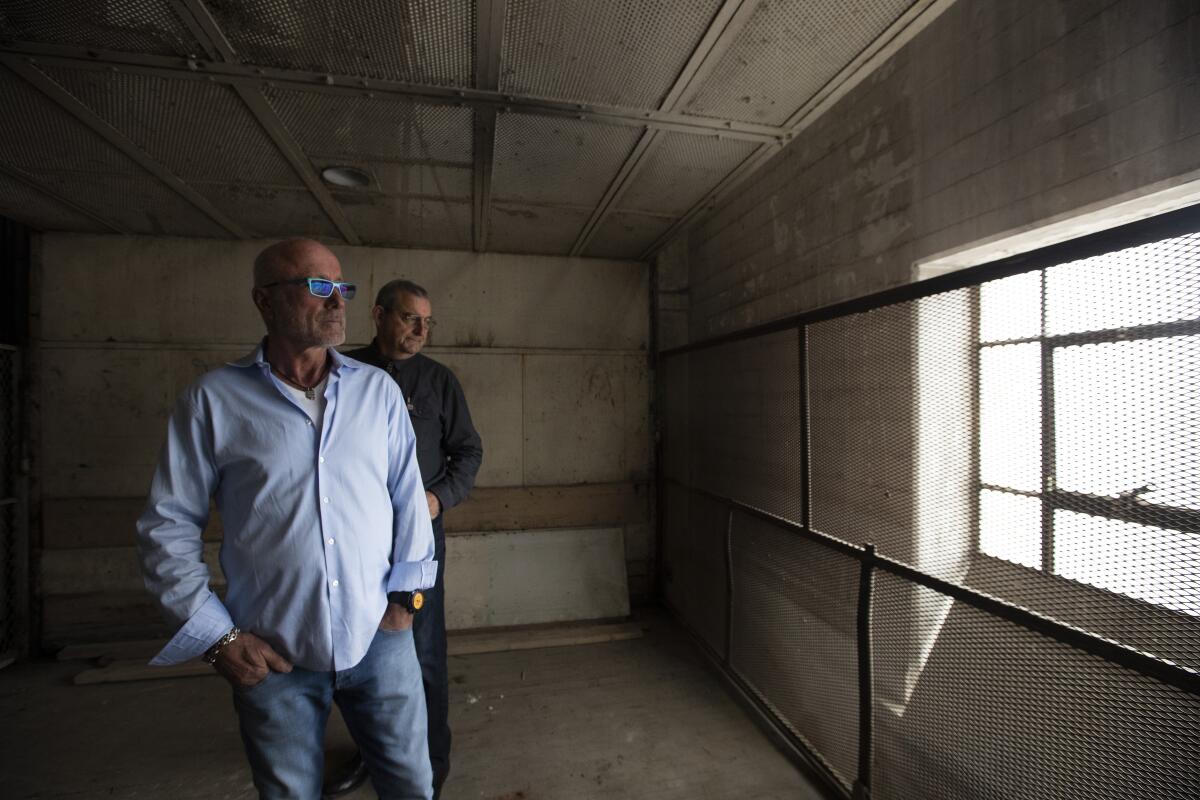
Shomof and Taormina have shared their Life Rebuilding Center idea with prospective partners and members of the Los Angeles City Council and county board of supervisors, but are now making it public. They say everyone who has heard about it has been impressed, if not flabbergasted by its ambition.
That’s the reaction I got when I contacted some of those in the know.
“I welcome people who want to productively work on solving this humanitarian crisis and house people as quickly as possible,” Boyle Heights Council Member Kevin de León said in a statement. “This is a gargantuan problem that requires all hands on deck to solve, so I am open to all solutions that can address the suffering we see with homelessness.”
“It’s big, isn’t it?” chuckled Sean Kelsey, general secretary for the California South division of the Salvation Army, for which he also serves as the Los Angeles Metro coordinator. He toured the Sears building last fall and said his organization “is honored to be a resource for them to see if this might be a solution.”
“It’s a little big,” said Illumination Foundation CEO Paul Leon. The Orange County-based nonprofit runs homeless shelters in Orange County, some financed by Taormina. “But if it gets built, we’ll definitely participate. I wish there was more people like Bill.”
A 50-page white paper claims the Life Rebuilding Center will be “known across the nation as the ultimate solution for managing homelessness issues in cities of all types and sizes.”
An impossible promise, I told Taormina, as we stared at the enormity of emptiness around us.
“It’s not just to take people off the street,” he responded. “It’s for everything.”
Readers share their memories of the iconic, nearly century-old Sears in Boyle Heights, which will soon close.
Shomof first gained prominence in the 2000s as a downtown Los Angeles developer nicknamed the “King of Spring” for buying and repurposing old commercial buildings. But the neighborhood is also where Shomof says his perspective on homelessness was forever sealed as a teenage immigrant in the 1970s.
“I was walking to work, and I saw someone pepper-spray a homeless man,” Shomof remembered. “I yelled at the attacker, and took water to the victim and washed his face. And I wondered, how could people in this country do this to a human?”
He involved himself in philanthropy for homeless over the years but grew frustrated as the population exploded in downtown and beyond. Then in 2019, Shomof read an article in the Times-owned Daily Pilot about Taormina. The scion of a waste-disposal dynasty that regularly hired formerly unhoused people, Taormina had earned respect from Orange County politicians and homeless activists alike for supporting solutions to the point of self-funding shelters himself, then letting others administer them.
Shomof toured a Taormina-supported shelter in Fullerton and was “amazed” at how multiple resources were gathered under one roof. The two met at the Sears building shortly after, where Shomof asked Taormina to imagine what he could do with it to fight homelessness. A few weeks later, Taormina pitched his Life Rebuilding Center concept to Shomof and his family at their Beverly Hills mansion during Shabbat dinner.
“Everyone looked at each other,” he said, “and said it was a beautiful thing.”
“I’ve got it made,” Shomof added, when I asked why he would forgo such a valuable piece of real estate instead of following through on his previous Mail Order District plans. “My life is beautiful. It’s time to give back. This is not about getting rich.”
Well, kind of.
According to the proposal he and Taormina crafted, the joint-powers authority that would oversee the Life Rebuilding Center would have to enter into a lease with Shomof of at least 20 years at an annual estimated cost of $23.3 million. At that rate, Shomof would easily earn back his investment before the lease was up.
Shomof justified the rent as a bargain for taxpayers in a city where a 2020 city controller audit said the price of a single unit of housing for the homeless was $531,000. A city where last fall, construction began on a 19-story tower in skid row that will eventually host 382 units. The cost of the first phase, according to my colleague Doug Smith? $160 million.
“Izek could’ve built anything here,” Taormina said, “but this project is the mark that he wants to set up as his legacy.”
We eventually made our way to the top of the Sears building and looked out toward the west. The downtown L.A. skyline shimmered on this clear, windy day. I then walked over to the south side of the building. Below, a homeless encampment took up most of an industrial street.
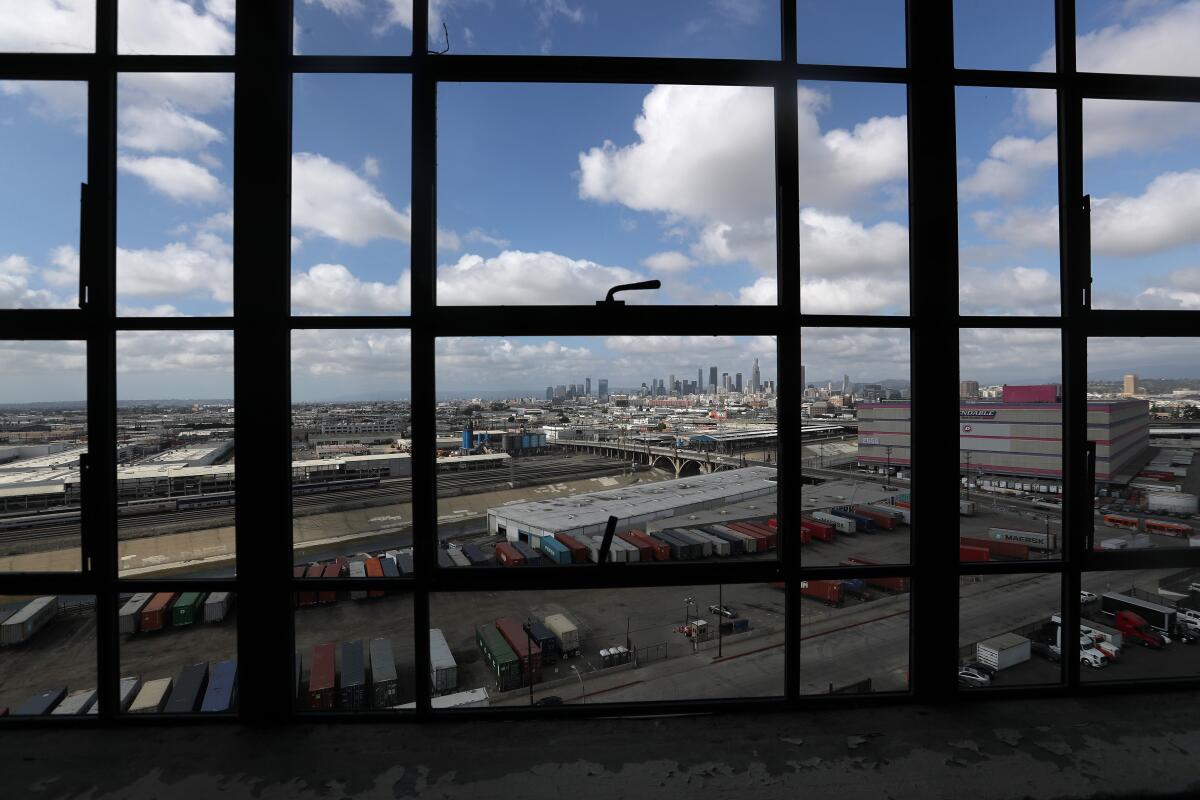
“You see all the people down there?” Shomof said. “They need to be here, to rebuild their lives.”
He and Taormina are confident that both the city and county will approve their plans this year, and that Boyle Heights residents will embrace them once they find out about it. The Life Rebuilding Center will also include a convenience store open to the public, and outposts for the L.A. fire and police departments. “This is not a shelter,” Shomof said, as we took the cargo elevator back to the first floor. “We will create jobs. We will be an asset and good neighbor.”
“I believe in the destiny of Izek, and I thank God that He has put me in the place to be his co-worker,” Taormina added. “If this doesn’t work to solve homelessness, nothing can.”
More to Read
Sign up for Essential California
The most important California stories and recommendations in your inbox every morning.
You may occasionally receive promotional content from the Los Angeles Times.
